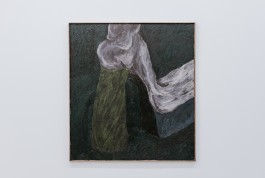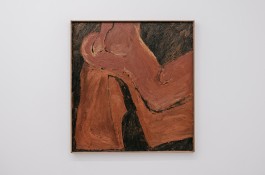


First solo exhibition in France -
STEVIE DIX
THE NEARER THE GROUND,
THE LOUDER IT SOUNDS
From 07 March – 14 June 2020
Opening Friday 06 March 2020, 18h – 21h













Boulevard Anspach, Stevie Dix, oil, beeswax and charcoal on canvas and wooden frame, 100x110 cm, 2020 © GALERIE CHLOE SALGADO and Stevie Dix
Exhibition view of The nearer the ground, the louder it sounds, Stevie Dix, 2020 © GALERIE CHLOE SALGADO and Stevie Dix
Walking here, Stevie Dix, oil, beeswax and charcoal on canvas and wooden frame, 75x70 cm, 2020 © GALERIE CHLOE SALGADO and Stevie Dix
Exhibition view of The nearer the ground, the louder it sounds, Stevie Dix, 2020 © GALERIE CHLOE SALGADO and Stevie Dix
The closer to the ground, the louder it sounds, Stevie Dix, oil, beeswax and charcoal on canvas and wooden frame, 75x70 cm, 2020 © GALERIE CHLOE SALGADO and Stevie Dix
Exhibition view of The nearer the ground, the louder it sounds, Stevie Dix, 2020 © GALERIE CHLOE SALGADO and Stevie Dix
Porte #1, Stevie Dix, ceramic, enamel and wooden frame, 33X49 cm, 2020 © GALERIE CHLOE SALGADO and Stevie Dix
Exhibition view of The nearer the ground, the louder it sounds, Stevie Dix, 2020 © GALERIE CHLOE SALGADO and Stevie Dix
Porte #2, Stevie Dix, ceramic, enamel and wooden frame, 33X49 cm, 2020 © GALERIE CHLOE SALGADO and Stevie Dix
Exhibition view of The nearer the ground, the louder it sounds, Stevie Dix, 2020 © GALERIE CHLOE SALGADO and Stevie Dix
Avenue Emile de Beco 41, Stevie Dix, oil, beeswax and charcoal on canvas and wooden frame, 55x60 cm, 2020 © GALERIE CHLOE SALGADO and Stevie Dix
Table #1, Stevie Dix, ceramic, enamel and wrought iron, 48x80x53 cm, 2020 © GALERIE CHLOE SALGADO and Stevie Dix
Running, Stevie Dix, oil, beeswax and charcoal on canvas and wooden frame, 45x50 cm, 2020 © GALERIE CHLOE SALGADO and Stevie Dix
GALERIE CHLOE SALGADO is pleased to invite you to The nearer the ground, the louder it sounds, Stevie Dix’s first solo exhibition in France.
Stevie Dix (1990, Genk) is a self-taught Belgian artist, living and working in Suffolk, England. After growing up in Genk, a small former coal mining town, Stevie Dix moved to London in 2010 to immerse herself in a more creative environment, and briefly studied at the alternative art school Turps Banana (2016-2017). She then moves a second time to Suffolk to join Asylum Studios, artist studios based on a former Royal Air Force airbase.
She presents her first solo exhibition, La Mauvaise Réputation, in 2016 at the Collectiv National gallery in Antwerp. The following year, in 2017, after a solo exhibition in London, England I Love You, But You’re Bringing Me Down at the Rob Barton Gallery, she presents two solo exhibitions in the USA: Conceived In El Coyote, at The Cabin, Los Angeles, and Tennis Elbow, at The Journal Gallery, New York City. In 2018, she presents two more solo exhibitions: Desert, at Nevven Gallery, Gothenburg, Sweden, and The Devil’s In The Details, at L21 Gallery, Palma de Mallorca, Spain.
The nearer the ground, the louder it sounds, at GALERIE CHLOE SALGADO, is Stevie Dix’s seventh solo exhibition, and her first one in France. All the works presented were created especially for the exhibition. The artist presents a new series of paintings, as well as her first ceramic pieces.
-
« What of shoes? What, shoes? Whose are the shoes? What are they made of? And even, who are they? » – Jacques Derrida, Restitutions, 1978
Brussels. It’s grey, wet. The city is grim, dreary. Charming for some, unappealing for others. A shadow emerges, yet we can’t quite make out the figure. A platform boot crashes into the frame, the sound of the collision between the sole of the shoe and the damp asphalt resonates in the space.
This scene that unfolds across the city of Brussels is now transported to Paris. The backdrop is the GALERIE CHLOE SALGADO, the director, Stevie Dix, who presents us with this abstracted depiction of a promenade through a city dear to her. However here, the cityscape is obscured, the human figure, absent. For Stevie Dix has focused on one element from her repertoire of symbols–– the shoe. Striding across a new series of paintings appears a herd of platform boots, each isolated against a black background entrusting them with power that goes way beyond that of a fashion accessory. Here, the exaggeratingly large boots play the lead role in the show materialising before us. Trapped somewhere between the footsteps and the gallery floor, the visitor is placed below, looking up at these exquisite creatures marching by. The nearer the ground, the louder it sounds.
The canvases presented are a departure from the artist’s often colourful works filled with objects in abstract compositions. Here, the object at question is enlarged, isolated, set against dark landscapes of heavy impasto. If the compositions evoke a certain uneasiness it is because the narrative before us is rooted in the artist’s personal history, evoking emotions of teenage angst, nostalgia, and the desire to escape. Shoes are “transmitters of power and stories, markers of status achieved [...] potent carriers of emotionality.”1 It is precisely this emotionality that Stevie Dix explores with her new series of paintings of platform boots that seem to be suspended in their march. Having grown up in an industrial city in Belgium, Stevie Dix would rummage through second hand shops collecting clothing and accessories from the 1970s, finding ways to escape banal everyday life through dressing up. Fascinated by the glam rock and punk movements, the artist would compose outfits in a home-grown cool2 style and venture to the Belgian capital to forget, albeit briefly, about the confinement that hometowns represent when we are young. To Stevie Dix, the platform boot was the vehicle to escapism.
This staging of the self evokes a certain theatricality that permeates through the exhibition with the repetition of gesture in a choreographed march. The multiple, heavy brushstrokes mimic the repetitive steps of the shoes they compose that reverberate in the space. Yet, this reverberation is not one of calmness. It evokes the anxiety ridden pulsation of the city. “The definition of true madness is repetition,” the artist claimed when speaking of her paintings. Far from a psychoanalysis of the self, this statement is rather a reference to the various characters and elements that make up delirious3 cityscapes, at times irrational, incomprehensible, yet omnipresent. The boots become monuments, skyscrapers towering over the viewer, penetrating the gallery-become-cityscape. And the city is the perfect environment in which one can escape, where one becomes at once anonymous and individual, where the act of walking alone allows for self-transformation. “A lone walker is both present and detached, more than an audience but less than a participant. Walking assuages or legitimizes this alienation.”4 This alienation is emphasized by the absence of the body, allowing for interpretation: these boots can be read as portraits of the artist, as anonymous individuals, and/or the collective self.
This question of anonymity and shoes in painting is one that has already marked the history of art. Vincent Van Gogh’s various paintings of shoes produced in the 1880s evoked various responses throughout the twentieth century. This debate began with Martin Heidegger’s analysis of the paintings as a way to illustrate the nature of art as a disclosure of truth. For Heidegger, the shoes represented the peasant; for Meyer Shapiro, they were the artist himself; for Jacques Derrida, anyone at all.5 Yet, what of truth? Or as Jacques Derrida questioned, what of shoes? This questioning of who the shoe represents seems far from relevant in the world portrayed by Stevie Dix as, here, the shoes are characters in and of themselves, at once containers, content and contained within their canvases. Indeed, they evoke the artist herself, as the act of painting is highly personal. Yet, they also represent various generations and people. These shoes are thus beings themselves, they are Stevie Dix, they are no one, they are everyone.
In The nearer the ground, the louder it sounds, the artist does not just transport us to an abstracted Belgian cityscape through the presence of platform boots, she also introduces elements that are derived from the material environment in which they wander. Little known and easily missed by passers-by, ceramic door handles embellish various buildings across Belgian cities. Flat like tiles, these ceramics are often decorated with abstract motifs from the mid-twentieth century. Inspired by these both decorative and functional elements from her home country, Stevie Dix’s first exploration of the ceramic medium has transformed the function of these objects to play a role in setting the stage alongside her monumental shoes.
“Walkers are 'practitioners of the city,' for the city is made to be walked. A city is a language, a repository of possibilities, and walking is the act of speaking that language, of selecting from those possibilities.”6 Stevie Dix presents us with a visual language, like a city, composed of boots and ceramics, an intimate perspective of the built environment. As visitors, or walkers, we navigate the space, inventing ways to interpret and reinterpret the cityscape that unfolds before us.
Katia Porro
1 Hilary Davidson, “Holding the Sole: Shoes, Emotions and the Supernatural,” in Feeling Things: Objects and Emotions through History, 2018.
2 Term borrowed from Dick Hebdige’s Subculture: The Meaning of Style, 1979.
3 A reference to the depiction of Manhattan in Rem Koolhaas’s Delirious New York.
4 Rebecca Solnit, Wanderlust: A history of Walking, 2000.
5 Martin Heidegger, The Origin of the Work of Art, 1950; Meyer Schapiro, “The Still Life as a Personal Object– A Note on Heidegger and Van Gogh,” 1968; Jacques Derrida, “Restitutions”, 1978.
6 Rebecca Solnit, Wanderlust: A history of Walking, 2000.